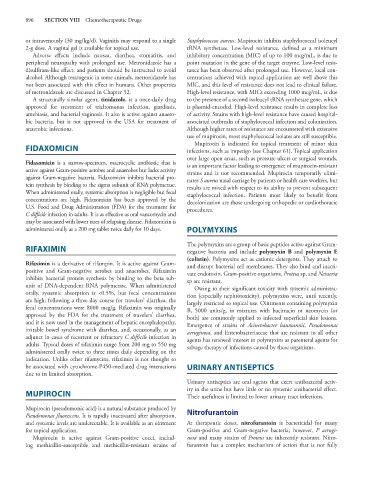Page 910 - Basic _ Clinical Pharmacology ( PDFDrive )
P. 910
896 SECTION VIII Chemotherapeutic Drugs
or intravenously (30 mg/kg/d). Vaginitis may respond to a single Staphylococcus aureus. Mupirocin inhibits staphylococcal isoleucyl
2-g dose. A vaginal gel is available for topical use. tRNA synthetase. Low-level resistance, defined as a minimum
Adverse effects include nausea, diarrhea, stomatitis, and inhibitory concentration (MIC) of up to 100 mcg/mL, is due to
peripheral neuropathy with prolonged use. Metronidazole has a point mutation in the gene of the target enzyme. Low-level resis-
disulfiram-like effect, and patients should be instructed to avoid tance has been observed after prolonged use. However, local con-
alcohol. Although teratogenic in some animals, metronidazole has centrations achieved with topical application are well above this
not been associated with this effect in humans. Other properties MIC, and this level of resistance does not lead to clinical failure.
of metronidazole are discussed in Chapter 52. High-level resistance, with MICs exceeding 1000 mcg/mL, is due
A structurally similar agent, tinidazole, is a once-daily drug to the presence of a second isoleucyl tRNA synthetase gene, which
approved for treatment of trichomonas infection, giardiasis, is plasmid-encoded. High-level resistance results in complete loss
amebiasis, and bacterial vaginosis. It also is active against anaero- of activity. Strains with high-level resistance have caused hospital-
bic bacteria, but is not approved in the USA for treatment of associated outbreaks of staphylococcal infection and colonization.
anaerobic infections. Although higher rates of resistance are encountered with extensive
use of mupirocin, most staphylococcal isolates are still susceptible.
Mupirocin is indicated for topical treatment of minor skin
FIDAXOMICIN infections, such as impetigo (see Chapter 61). Topical application
over large open areas, such as pressure ulcers or surgical wounds,
Fidaxomicin is a narrow-spectrum, macrocyclic antibiotic that is is an important factor leading to emergence of mupirocin-resistant
active against Gram-positive aerobes and anaerobes but lacks activity strains and is not recommended. Mupirocin temporarily elimi-
against Gram-negative bacteria. Fidaxomicin inhibits bacterial pro- nates S aureus nasal carriage by patients or health care workers, but
tein synthesis by binding to the sigma subunit of RNA polymerase. results are mixed with respect to its ability to prevent subsequent
When administered orally, systemic absorption is negligible but fecal staphylococcal infection. Patients most likely to benefit from
concentrations are high. Fidaxomicin has been approved by the decolonization are those undergoing orthopedic or cardiothoracic
U.S. Food and Drug Administration (FDA) for the treatment for procedures.
C difficile infection in adults. It is as effective as oral vancomycin and
may be associated with lower rates of relapsing disease. Fidaxomicin is
administered orally as a 200 mg tablet twice daily for 10 days. POLYMYXINS
RIFAXIMIN The polymyxins are a group of basic peptides active against Gram-
negative bacteria and include polymyxin B and polymyxin E
(colistin). Polymyxins act as cationic detergents. They attach to
Rifaximin is a derivative of rifampin. It is active against Gram- and disrupt bacterial cell membranes. They also bind and inacti-
positive and Gram-negative aerobes and anaerobes. Rifaximin vate endotoxin. Gram-positive organisms, Proteus sp, and Neisseria
inhibits bacterial protein synthesis by binding to the beta sub- sp are resistant.
unit of DNA-dependent RNA polymerase. When administered Owing to their significant toxicity with systemic administra-
orally, systemic absorption is <0.5%, but fecal concentrations tion (especially nephrotoxicity), polymyxins were, until recently,
are high; following a three day course for travelers’ diarrhea, the largely restricted to topical use. Ointments containing polymyxin
fecal concentrations were 8000 mcg/g. Rifaximin was originally B, 5000 units/g, in mixtures with bacitracin or neomycin (or
approved by the FDA for the treatment of travelers’ diarrhea, both) are commonly applied to infected superficial skin lesions.
and it is now used in the management of hepatic encephalopathy, Emergence of strains of Acinetobacter baumannii, Pseudomonas
irritable bowel syndrome with diarrhea, and, occasionally, as an aeruginosa, and Enterobacteriaceae that are resistant to all other
adjunct in cases of recurrent or refractory C difficile infection in agents has renewed interest in polymyxins as parenteral agents for
adults. Typical doses of rifaximin range from 200 mg to 550 mg salvage therapy of infections caused by these organisms.
administered orally twice to three times daily depending on the
indication. Unlike other rifamycins, rifaximin is not thought to
be associated with cytochrome-P450-mediated drug interactions URINARY ANTISEPTICS
due to its limited absorption.
Urinary antiseptics are oral agents that exert antibacterial activ-
MUPIROCIN ity in the urine but have little or no systemic antibacterial effect.
Their usefulness is limited to lower urinary tract infections.
Mupirocin (pseudomonic acid) is a natural substance produced by Nitrofurantoin
Pseudomonas fluorescens. It is rapidly inactivated after absorption,
and systemic levels are undetectable. It is available as an ointment At therapeutic doses, nitrofurantoin is bactericidal for many
for topical application. Gram-positive and Gram-negative bacteria; however, P aerugi-
Mupirocin is active against Gram-positive cocci, includ- nosa and many strains of Proteus are inherently resistant. Nitro-
ing methicillin-susceptible and methicillin-resistant strains of furantoin has a complex mechanism of action that is not fully

